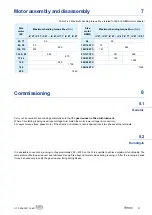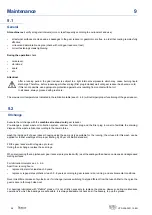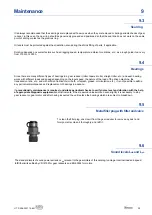
Installation of gear reducer
5
Before installing,
check that:
•
the shafts and contact surfaces are not damaged;
•
gear reducer specifi cations are suitable for ambient conditions (temperature, atmosphere, etc.);
•
the structure on which the gear reducer is secured is fl at, levelled and suffi ciently dimensioned to ensure installation stability
and absence of vibrations, (vibration speed
v
eff
≤ 3,5 mm/s for
P
N
< 15 kW and
v
eff
< 4,5 mm/s for
P
N
> 15 kW are acceptable),
taking into account all transmitted forces due to masses, torque, radial and axial loads;
•
the mounting position intended use corresponds to that indicated on name plate.
Attention!
Take the greatest care when aligning the gearmotor with the machine to be driven (use shims if necessary).
Incorrect alignment may cause breakdown of shafts and/or bearings (which may cause overheatings) which
may represent heavy danger for people.
Position the gear reducer so as to allow a free passage of air for cooling both gear reducer and motor (especially at their fan side);
Avoid any obstruction to the air fl ow; heat sources near the gear reducer that might aff ect the temperature of cooling air and of
gear reducer (for radiation); insuffi cient air recycle and applications hindering the steady dissipation of heat;
Verify that the gear reducer housing is dust-free in order to achieve an effi cient heat dispersal.
Place the supplied adhesive pictogram identifying the risk associated with hot surfaces on the surface of the
gearbox in a position visible to personnel involved in the operation and maintenance of the machine (taken
from UTD189).
Mating surfaces (of gear reducer and machine) must be clean and suffi ciently rough to provide a good friction coeffi cient (indicatively
Ra
3,2 ÷ 6,3 µm).
Remove by a scraper or solvent the eventual paint of gear reducer coupling surfaces
When external loads are present use pins or locking blocks, if necessary.
When fi tting gear reducer and machine and/or gear reducer and eventual fl ange
B5
it is recommended to use
locking adhesives
such as LOCTITE on the fastening screws (also on fl ange mating surfaces).
For accessories not supplied by Rossi, pay attention to their dimensioning; consult us, if need be.
Before wiring-up the gearmotor make sure that motor voltage corresponds to input voltage. If direction of rotation is not as desired,
invert two phases at the terminals.
Y-∆ starting should be adopted for no-load starting (or with a very small load) and for smooth starts, low starting current or other
similar devices should be fi tted.
If overloads are imposed for long periods or if shocks or danger of jamming are envisaged, then motor-protection, electronic torque
limiters, fl uid couplings, safety couplings, control units or other similar devices should be fi tted.
Usually protect the motor with a thermal cut-out
however, where duty cycles involve a high number of on-load starts, it is
necessari to utilise
thermal probes
for motor protection (fi tted on the wiring); magnetothermic breaker is unsuitable since its
threshold must be set higher than the motor nominal current of rating.
Connect thermal probes, if any, to auxiliary safety circuits.
Use varistors and/or RC fi lters to limit voltage peaks due to contactors.
Whenever a leakage of lubricant could cause heavy damages, increase the frequency of inspections and/or envisage appropriate
control devices (e.g.: remote level gauge, etc.).
In polluting surroundings, take suitable precautions against lubricant contamination through seal rings or other.
For outdoor installations or aggressive environments, paint the gear reducer or gearmotor with a suitable anti-corrosive paint (see
ch. 3.4), protecting it with water-repellent grease (especially in position with the rotating seats of the seal rings and the access
areas on the shaft ends).
Gearmotors should be protected wherever possible, and by whatever appropriate means, from solar radiation and extremes of
weather; weather protection
becomes essential for V5 and V6 mounting positions.
For ambient temperature greater than +40 °C or less than 0 °C, consult Rossi.
5.1
General
14
UT.D 208-2021.12-EN















































